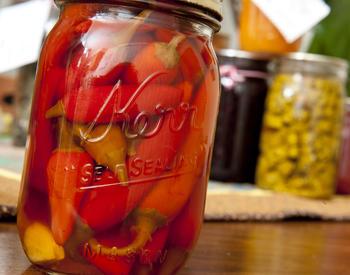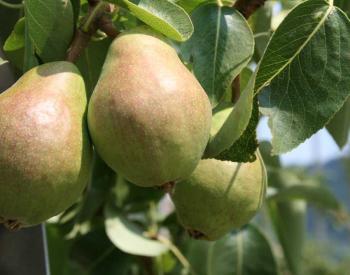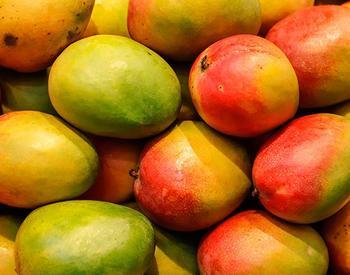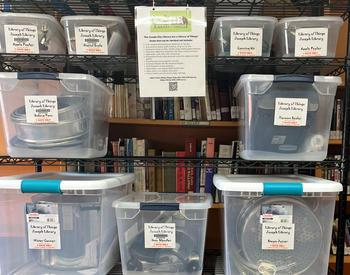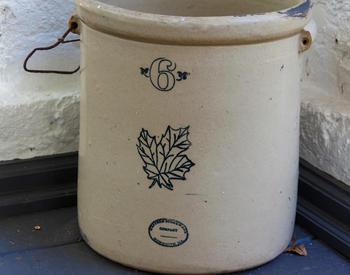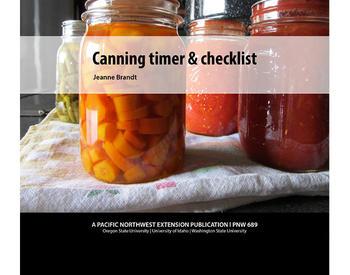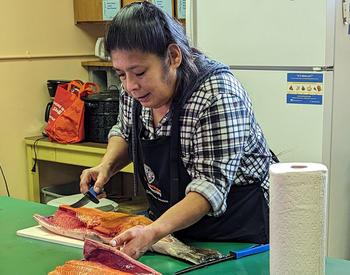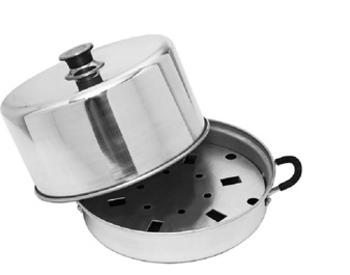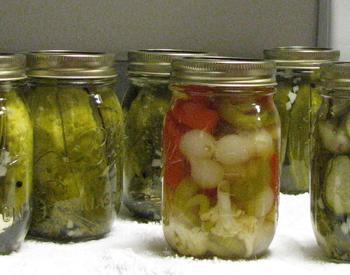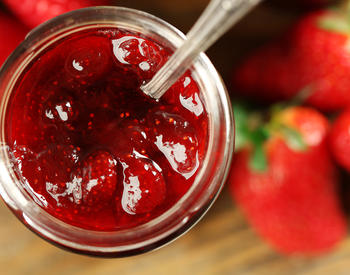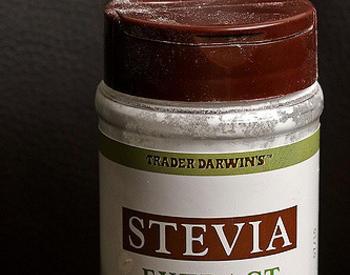Download this publication as a PDF
There are many varieties of berries grown in the Pacific Northwest. Strawberries are usually the first to ripen in the late spring, followed by raspberries, currants and blackberries, which include loganberries, marionberries, boysenberries, Cascade, youngberry, and the wild evergreen and Himalayan varieties. There are also several varieties of blueberries available.
Berries can be canned, frozen or dried and are excellent as fruit spreads and syrups.
How many to pick
The exact quantity will depend on the variety and size of the berry. This is a rough estimate.
- Two pounds of fresh berries will yield 1 quart of frozen or canned berries.
- Every quart of fresh berries will yield approximately 1 cup of juice for jelly or 2 cups of mashed berries for jam.
- A 36-pound crate of whole berries will yield approximately 18–24 quarts.
Harvesting
It is best to pick berries early in the morning when it is cool. Picked berries lose freshness quickly in heat. Place berries in the shade or refrigerate. Do not wash berries until just before you plan to use them.
Canning whole
All varieties of berries, with the exception of strawberries, may be canned. Strawberries become very mushy and lose their color and flavor when canned.
Choose ripe, sweet berries with uniform color. Wash 1 to 2 quarts of berries at a time. Drain and remove cap and stem, if necessary. Berries may be canned in sugar syrup, water or natural juices. They will hold their shape and retain their natural color if canned in syrup or in natural juices.
For a 9 pint load, use the following proportion for sugar syrup:
| Type of syrup | Cups of water | Cups sugar |
|---|---|---|
| Very light | 6 1/2 | 3/4 |
| Light | 5 3/4 | 1 1/2 |
| Medium | 5 1/4 | 2 1/4 |
| Heavy | 5 | 3 1/4 |
Hot pack
Dip berries in boiling water, syrup or juice for 30 seconds; drain. Leaving 1⁄2-inch headspace. Adjust lids and process in boiling water canner: pints and quarts 15 minutes. After processing, take canner off heat. Remove lid and wait 5 minutes before removing jars. Check with your county Extension Office for altitude adjustments over 1,000 feet.
Raw pack
Fill jars with raw berries, shaking down gently while filling. Cover with hot syrup, juice or water, leaving 1⁄2-inch headspace. Adjust lids and process in boiling water canner: pints for 15 minutes, quarts, 20 minutes. After processing, take canner off heat. Remove lid and wait 5 minutes before removing jars. Check with your county Extension Office for altitude adjustments over 1,000 feet.
Note: There will be more floating fruit using the raw pack method.
Freeze
This is the preferred way if you have not yet determined their use. To freeze individually, wash berries, drain well and place in a single layer on a baking sheet. Freeze berries until firm, then package frozen berries in freezer bags or containers. If it is not important to have the berries individually frozen, wash, drain and package immediately into freezer containers.
Berries frozen dry can be used in making jams, jellies, pies, cobblers or syrups.
In sugar: Wash berries; drain. Sprinkle with sugar to taste and let sit until sugar is completely dissolved. Package in freezer bags or containers.
Berries frozen in pectin
If berries will be used as topping for ice cream, pancakes or waffles, or eaten as a side dish, freeze them in a mixture of sugar and pectin. The pectin mixture will help the berries retain their firmness and bright color after they are thawed. It is an excellent way to freeze sliced strawberries and raspberries.
Mix together:
- 3 cups white sugar
- 1 package powdered fruit pectin
Sprinkle sugar/pectin mixture over berries and let sit until dissolved. For whole berries, coat with the sugar/pectin mixture and put in a single layer on a cookie sheet. Place in the freezer. When berries are frozen, remove from cookie sheet and place berries in freezer bags or freezer containers.
Note: This is enough pectin/sugar mixture for approximately 3 gallons of berries. The amount of sugar can be adjusted to taste.
Berries in syrup
For syrup recipe, follow canning directions. Cool syrup before using. Place berries loosely into freezer containers. Cover with cold sugar syrup, leaving 1-inch headspace. Freeze. The sugar syrup will help the berries retain their firmness.
When freezing berries in freezer boxes, it is helpful to place a piece of crumpled plastic wrap on top of the berries to hold them under the liquid.
Store frozen berries at 0°F and use within 1 year for best quality.
Jams and jellies
Both frozen and fresh berries are excellent made into jams, jellies and fruit syrups. There are many commercial pectin products on the market that include recipes for making homemade fruit spreads.
Making Berry Syrups at Home (SP 50-632) gives detailed instructions for making berry syrups.
Dry
Blackberries (all varieties) and raspberries are not recommended for drying because of their high seed content and slow drying time. They do make excellent fruit leathers.
Blueberries
Select large, firm, fully ripe berries that have a deep, blue color. Wash berries and remove the stems. Blueberries may be dried without any pretreatment, but will dry faster if they are dipped in boiling water to crack the skins before drying. When blueberries are dried with no pretreatment, they will be puffy in appearance and texture. Those dipped in boiling water will be raisin-like in quality.
Blueberries are dry when they are leathery and pliable with no pockets of moisture. They are excellent eaten as a snack or added to cereal, baked products and pancakes.
Strawberries
The sweeter varieties are best for drying. Select firm, ripe, red berries with a solid color. They should be picked when fully ripe for best flavor. Wash berries, remove caps and cut into 1⁄2-inch slices or cut smaller berries in half. Dry skin-side down. No pretreatment is necessary. Strawberries are dry when they are pliable and leathery with no pockets of moisture.
Dried strawberries can be eaten as a snack, added to cooked and dry cereals, combined with granola, or added to milkshakes or yogurt. They are better eaten dry because they lose their firm texture when rehydrated.
Berry leathers
Berries of all kinds can be puréed, either by themselves or in combination with other fruits, such as apples and pears, to make fruit leathers. It is desirable to remove seeds from the purée since they become very hard after they are dried.
To make fruit leathers, purée berries, strain seeds, sweeten to taste and pour on a leather drying sheet, drying tray or cookie sheet, covered with plastic wrap. Place in a dehydrator or warm oven (145°F) and dry until leathery with no moisture pockets.
Remove from drying tray and roll or cut into bite-size pieces. Wrap and store in a cool, dry place.
For more information on making fruit leathers, ask for handout FS 232 Making Dried Fruit Leathers available at your local county Extension Office and online.
Canned pie fillings
Fresh and frozen berries may be made into canned pie fillings using Clear-Jel1 , a modified food starch, as the thickener. The Extension publication Fruit Pie Fillings (SP 50-616) has instructions for making the pie fillings.
Source: OSU Master Food Preserver Program
- 1Reference to Clear-Jel in this publication is not intended as an endorsement of the product.
